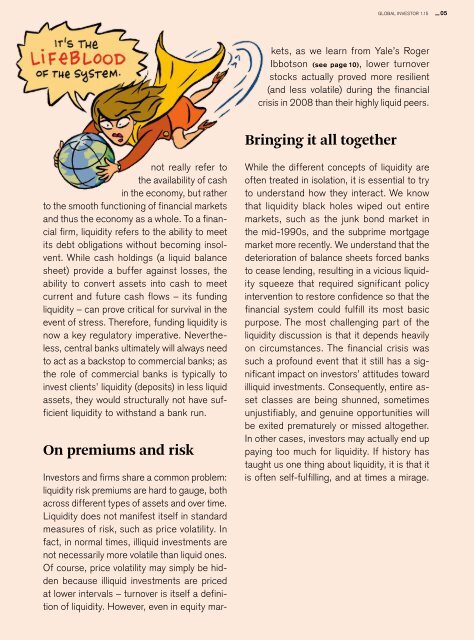Illiquid assets
Unwrapping alternative returns Global Investor, 01/2015 Credit Suisse
Unwrapping alternative returns
Global Investor, 01/2015
Credit Suisse
You also want an ePaper? Increase the reach of your titles
YUMPU automatically turns print PDFs into web optimized ePapers that Google loves.
GLOBAL INVESTOR 1.15 — 05<br />
Investors and firms share a common problem:<br />
liquidity risk premiums are hard to gauge, both<br />
across different types of <strong>assets</strong> and over time.<br />
Liquidity does not manifest itself in standard<br />
measures of risk, such as price volatility. In<br />
fact, in normal times, illiquid investments are<br />
not necessarily more volatile than liquid ones.<br />
Of course, price volatility may simply be hidden<br />
because illiquid investments are priced<br />
at lower intervals – turnover is itself a definition<br />
of liquidity. However, even in equity markets,<br />
as we learn from Yale’s Roger<br />
Ibbotson (see page 10), lower turnover<br />
stocks actually proved more resilient<br />
(and less volatile) during the financial<br />
crisis in 2008 than their highly liquid peers.<br />
Bringing it all together<br />
not really refer to<br />
the availability of cash<br />
in the economy, but rather<br />
to the smooth functioning of financial markets<br />
and thus the economy as a whole. To a financial<br />
firm, liquidity refers to the ability to meet<br />
its debt obligations without becoming insolvent.<br />
While cash holdings (a liquid balance<br />
sheet) provide a buffer against losses, the<br />
ability to convert <strong>assets</strong> into cash to meet<br />
current and future cash flows – its funding<br />
liquidity – can prove critical for survival in the<br />
event of stress. Therefore, funding liquidity is<br />
now a key regulatory imperative. Nevertheless,<br />
central banks ultimately will always need<br />
to act as a backstop to commercial banks; as<br />
the role of commercial banks is typically to<br />
invest clients’ liquidity (deposits) in less liquid<br />
<strong>assets</strong>, they would structurally not have sufficient<br />
liquidity to withstand a bank run.<br />
On premiums and risk<br />
While the different concepts of liquidity are<br />
often treated in isolation, it is essential to try<br />
to understand how they interact. We know<br />
that liquidity black holes wiped out entire<br />
markets, such as the junk bond market in<br />
the mid-1990s, and the subprime mortgage<br />
market more recently. We understand that the<br />
deterioration of balance sheets forced banks<br />
to cease lending, resulting in a vicious liquidity<br />
squeeze that required significant policy<br />
intervention to restore confidence so that the<br />
financial system could fulfill its most basic<br />
purpose. The most challenging part of the<br />
liquidity discussion is that it depends heavily<br />
on circumstances. The financial crisis was<br />
such a profound event that it still has a significant<br />
impact on investors’ attitudes toward<br />
illiquid investments. Consequently, entire asset<br />
classes are being shunned, sometimes<br />
unjustifiably, and genuine opportunities will<br />
be exited prematurely or missed altogether.<br />
In other cases, investors may actually end up<br />
paying too much for liquidity. If history has<br />
taught us one thing about liquidity, it is that it<br />
is often self-fulfilling, and at times a mirage.

















